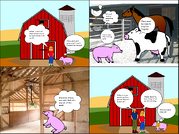In Classroom Instruction that Works, Robert Marzano, Debra Pickering, and Jane Pollock examine decades of research and distill the results into nine teaching strategies that have a significant, positive impact on student learning. Student learning with creative software tools matches and supports many effective instructional strategies, including those mentioned in this book.
Identifying Similarities and Differences
Identifying similarities and differences can be done in many ways, including comparisons, classifications, creating metaphors, and creating analogies. Specific mention is given to the strategy of “representing similarities and differences in graphic or symbolic form enhances students’ understanding of and ability to use knowledge.”
Graphic organizers like Venn diagrams, webs, and classification charts help students compare and classify in a visual or symbolic form. Teach students a variety of organizers and give them opportunities to determine for themselves what sort of organizer would be most helpful.
 Another fun way to have students write and create to identify similarities and differences is through the creation of an If… But report. This type of projects includes a sentence or paragraph that begins with “If I were” or “If I visited” to describe their one topic and follows with “But I would not” to describe the second topic. (Explore more If... But examples).
Another fun way to have students write and create to identify similarities and differences is through the creation of an If… But report. This type of projects includes a sentence or paragraph that begins with “If I were” or “If I visited” to describe their one topic and follows with “But I would not” to describe the second topic. (Explore more If... But examples).
Summarizing and Note Taking
Summarizing involves deleting, substituting, and evaluating information, and requiring students to engage in detailed analysis of the content.
To get students excited about engaging in detailed analysis with the content, have them design and develop comic strips. While the visual (or nonlinguistic) nature of comics may be the more obvious connection to Classroom Instruction That Works, because of the limited amount of text available in this format, it is a great vehicle to help students summarize. The limited amount of space in a comic’s panels requires students to choose the most significant points in a text or story.
Nonlinguistic representations
 Creating nonlinguistic representations of knowledge requires students to organize and elaborate on information. Marzano and team state, “the more we use both systems of representation – linguistic and non-linguistic – the better we are able to think about and recall knowledge.” Comics are a natural marriage of these two forms of representation.
Creating nonlinguistic representations of knowledge requires students to organize and elaborate on information. Marzano and team state, “the more we use both systems of representation – linguistic and non-linguistic – the better we are able to think about and recall knowledge.” Comics are a natural marriage of these two forms of representation.
Designing comics not only provides relevance to classroom projects, the visual nature supports visual and second-language learners, allowing them to demonstrate knowledge even when they don’t know the words. By combining visual support with necessary text practice, designing comics is a great way to build confidence and develop linguistic proficiencies.
Cooperative Learning
Having students work together to complete projects prepares students for life in the world outside of the classroom where “most complex communal, social, and workplace problems are solved by groups, not individuals.” Whether each student contributes a page, or paragraph, or painting to a cooperative class project, or works with a team to complete work collaboratively, they learn to recognize and value the various perspectives and contributions of themselves and others.
The best part about using a creative approach to improving student learning? It’s fun for both you and your students. Have fun making with creativity software!







